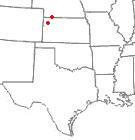|

Colby, Kansas | I'll agree with some of the other responses (soybeans and cotton) and add one more: sunflowers. The problem we see here in dryland agriculture is that planting one of these crops begins a snowball effect. Years of studies involving soybeans and sunflowers here all point to the same conclusion - everything sucks after them. For us it all comes back to surface residue and reducing evaporation, if the previous crop didn't leave any residue (soybean or sunflower) then your next crop is basically in a bare soil condition and yields suffer greatly, thus it produces less residue and the cycle continues to spiral. Here in the early 2000's under sustained drought it became tougher and tougher to raise a crop partially because of this. Only now are the residue levels in some fields starting to recover.
Any type of perennial system (i.e. grass hay) actually does a great job because of the tremendous amount or below-ground biomass. Every crop year it can add on to what is already there rather than rebuild.
Reducing losses in OM can be done through management, building OM is an extremely difficult thing to do just because of the tremendous amount of residue to make a difference. A stumbled across a good tid-bit on the Noble Foundation website.
http://www.noble.org/ag/Soils/OrganicMatter/Index.htm
How Much Organic Matter Is in the Soil?
An acre of soil measured to a depth of 6 inches weighs approximately 2,000,000 pounds, which means that 1 percent organic matter in the soil would weigh about 20,000 pounds per acre. Remember that it takes at least 10 pounds of organic material to decompose to 1 pound of organic matter, so it takes at least 200,000 pounds (100 tons) of organic material applied or returned to the soil to add 1 percent stable organic matter under favorable conditions.
In soils that formed under prairie vegetation, organic-matter levels are generally comparatively high because organic material was supplied from both the top growth and the roots. We don't usually think of roots as supplying organic material, but a study in the Upper Great Plains showed that a mixed prairie had an above-ground (shoot) yield of 1.4 tons of organic material per acre, while the root yield was about 4 tons per acre. The plants were producing roots that were more than twice the weight of the shoots.
Lucas
Edited by LHaag 8/27/2009 10:30
| |
|


 worst crop for orhanic matter?
worst crop for orhanic matter?